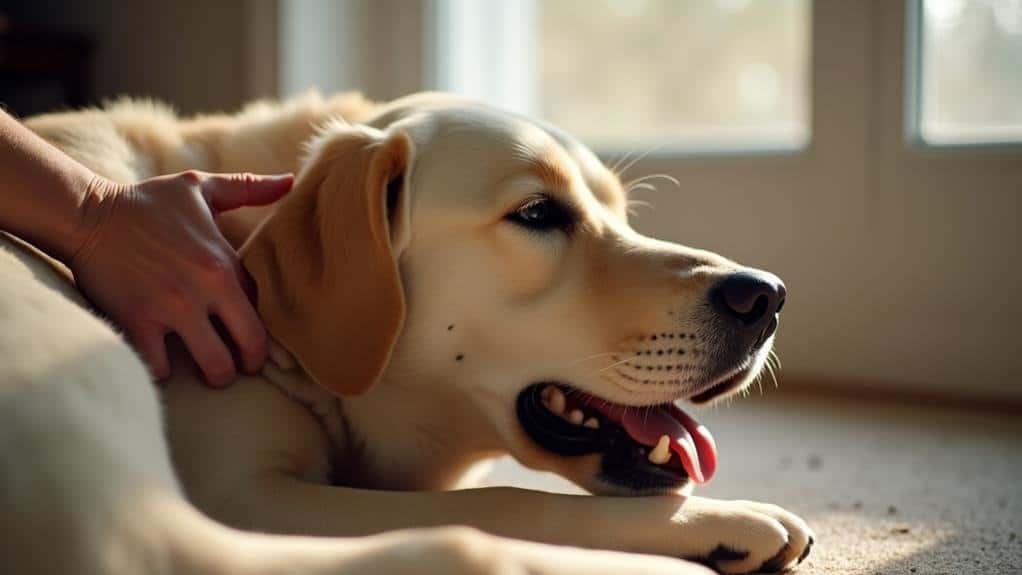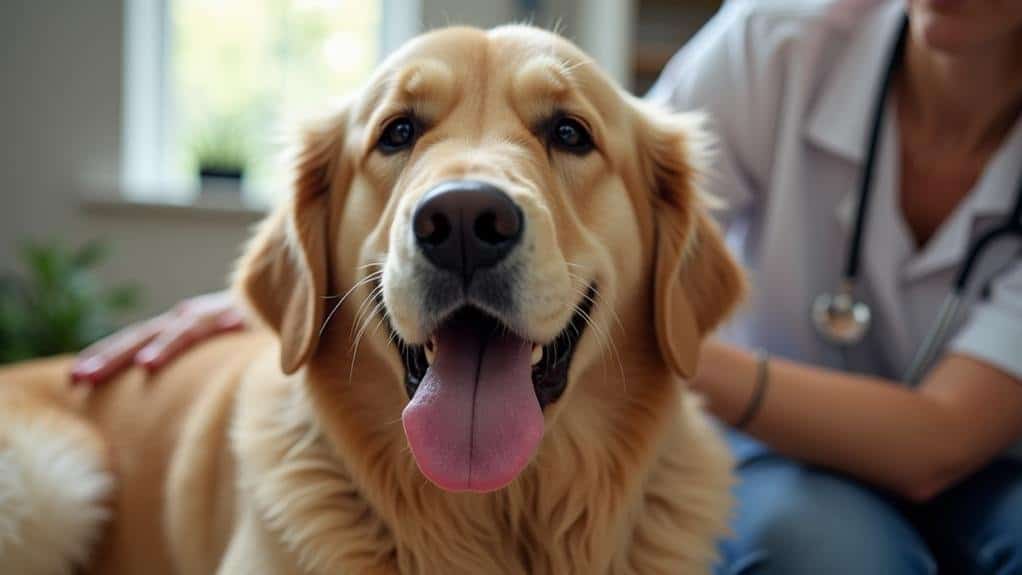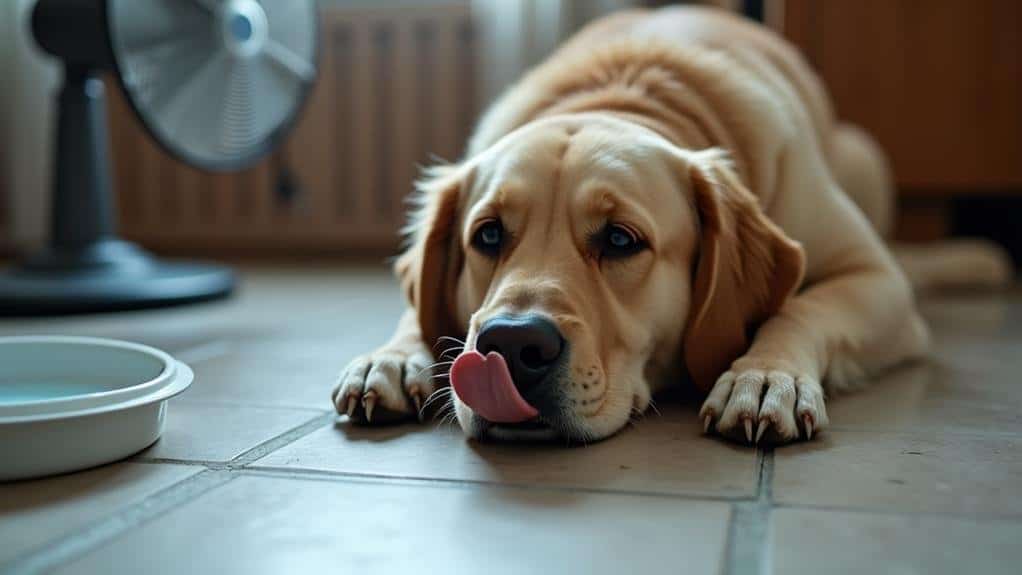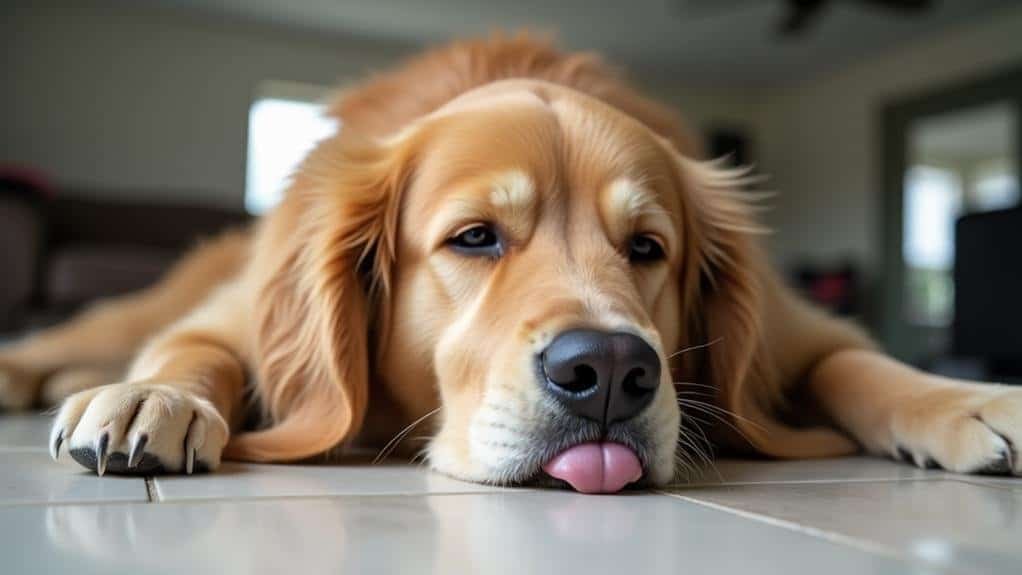Your dog's panting while resting could be normal or a sign of an underlying issue. Dogs pant to cool down, but excessive panting at rest might indicate health problems like heart disease, pain, or anxiety. Normally, dogs breathe 15-35 times per minute when relaxed. If your pup's breathing exceeds this rate or comes with symptoms like lethargy or loss of appetite, it's time to consult your vet. Keep an eye on your furry friend's panting patterns, guarantee they have access to cool areas and fresh water, and monitor for any changes in behavior. Understanding the various causes can help you better care for your canine companion.
Understanding Normal Dog Panting

If you've ever watched your dog pant while resting, you might've wondered if it's normal. Understanding dog panting is essential for monitoring your pet's health. Normal breathing rates for healthy dogs at rest range from 15 to 35 breaths per minute, but this can increase during panting.
Panting serves as a cooling mechanism for dogs, who lack sweat glands. It helps regulate body temperature through increased airflow and evaporation of moisture from the tongue.
However, excessive panting (more than 30 breaths per minute at rest) could indicate underlying health issues.
It's important to note that individual variations in breathing patterns exist. Factors like breed, age, and fitness level can influence your dog's panting habits.
As a responsible pet owner, you should:
- Familiarize yourself with your dog's normal respiratory rate
- Monitor for any changes in panting frequency or intensity
- Observe if panting decreases within 5-10 minutes after exercise or heat exposure
Signs of Excessive Panting

Many dog owners struggle to differentiate between normal and excessive panting. If you're wondering whether your furry friend's breathing is cause for concern, here are some signs to watch out for:
1. Frequency and Duration:
Your dog's normal respiratory rate at rest should be less than 30 breaths per minute. If you notice your pup panting more than this, especially when they're not active or in a cool environment, it might be excessive panting.
2. Appearance and Sound:
Keep an eye out for open-mouth breathing and listen for loud or noisy respiration. These can be indicators that your dog's panting isn't just a normal cooldown.
3. Accompanying Symptoms:
If excessive panting comes with lethargy, loss of appetite, or unusual gum color, it's time to call the vet. These signs could point to an underlying health issue that needs diagnosis and treatment.
4. Sudden Onset:
Has your dog's panting pattern changed abruptly? This sudden shift, especially if paired with signs of distress, is a red flag that shouldn't be ignored.
Common Causes of Resting Panting

After recognizing excessive panting, it's important to understand why your dog might be breathing heavily while at rest. There are several common causes of resting panting that you should be aware of:
1. Underlying Health Issues
Your dog's excessive panting while resting could be a sign of serious health problems. Heart disease, lung disease, or Cushing's disease may cause your furry friend to pant more than usual. If you're concerned, it's best to consult your vet for a proper evaluation.
2. Breed-Specific Concerns
If you've got a squishy-faced pup like a pug or bulldog, you're probably no stranger to their noisy breathing. These brachycephalic breeds are more prone to respiratory issues and may pant excessively even when they're just lounging around.
3. Pain and Discomfort
Is your older dog panting more while resting? Arthritis or other painful conditions might be the culprit. When Fido can't get comfy, he might pant more as a result.
4. Environmental Factors
Sometimes, the cause is as simple as a hot day. High temperatures and humidity can make your dog pant more, even when they're not active.
5. Anxiety and Stress
If your pup's a bit of a worry-wart, anxiety-induced panting might be the issue. Loud noises or separation anxiety can lead to increased breathing, even during rest.
When to Consult a Veterinarian

While monitoring your dog's panting is important, knowing when to seek professional help is essential. Here are some key signs that it's time to consult a veterinarian:
- Excessive Panting: If your furry friend is panting more than 35 breaths per minute while resting, it's time for a check-up. This could indicate underlying health issues that need attention.
- Accompanying Symptoms: Keep an eye out for lethargy, loss of appetite, or changes in behavior alongside the panting. These red flags warrant immediate veterinary consultation.
- Respiratory Distress: If you notice blue or purple gums (cyanosis) or labored breathing, don't wait! These symptoms could signal a serious oxygen deficiency and require prompt medical attention.
- Sudden Onset: When your pup starts panting excessively out of the blue, it's better to be safe than sorry. This could be a sign of a medical emergency, so don't hesitate to call your vet.
Managing Excessive Panting at Home

Now that you know when to seek professional help, let's focus on steps you can take at home to manage your dog's excessive panting.
First, make certain your furry friend has access to a cool, shaded area and plenty of fresh water. Dehydration and overheating can make panting worse, so keep your pup comfortable!
Monitor your dog's breathing patterns by counting breaths per minute. If it's over 30 while resting, it might be time to dig deeper. But don't worry, there are ways to help:
- Gentle exercise: A calm walk can ease anxiety and restlessness, reducing stress-related panting.
- Climate control: Use fans or air conditioning to maintain a comfortable indoor temperature, especially during those dog days of summer.
- Keep a log: Track your dog's panting episodes, noting any other symptoms or behavior changes. This info will be gold for your veterinarian if needed.
Frequently Asked Questions
When Should I Worry About Dog Panting?
You should worry about your dog's panting if it's excessive at rest, over 35 breaths per minute, or accompanied by lethargy, loss of appetite, or abnormal gum color. Sudden onset without clear cause also warrants immediate veterinary attention.
Why Is My Dog Panting so Much While Laying Down?
Your dog's excessive panting while laying down could be due to various reasons. It might be a sign of health issues, discomfort, or environmental factors. You should monitor their breathing rate and consult a vet if it persists or worsens.
Why Is My Dog Panting so Fast While Resting?
Your dog's fast panting while resting could indicate several issues. It might be experiencing heat stress, pain, anxiety, or respiratory problems. If it's not hot and they haven't exercised recently, you should consult a vet for a proper diagnosis.
How Much Panting Is Too Much for a Dog?
You'll know your dog's panting is excessive if it's over 40 breaths per minute while resting. It's too much if it persists beyond 10 minutes after exercise or if it's accompanied by other concerning symptoms.
Conclusion
Your dog's panting while resting could be normal or a sign of an underlying issue. Remember, it's always better to be safe than sorry when it comes to your furry friend's health. If you're concerned, don't hesitate to consult your vet, especially if the panting is excessive or accompanied by other symptoms. By staying observant and proactive, you'll guarantee your pup stays happy, healthy, and comfortable. After all, a content canine means a happy home for everyone!

